How to Nominate Someone for Honorary Membership to the CSLA
Honorary Membership recognizes persons who have performed notable service in advancing the cause of landscape architecture.
To nominate someone for honorary membership, address a letter to the CSLA Board which contains the reasons why you think this person should receive honorary membership to the society. Please include as much information as possible on the nominee and their links to landscape architecture. You can include letters of support from others, as well. The Executive Director will present the letter to the Board. Please keep the nomination process as confidential as possible until the board's decision.
CSLA Bestows Honorary Membership on The Honorable Murray Sinclair and Niigaan Sinclair
The Honorable Murray Sinclair
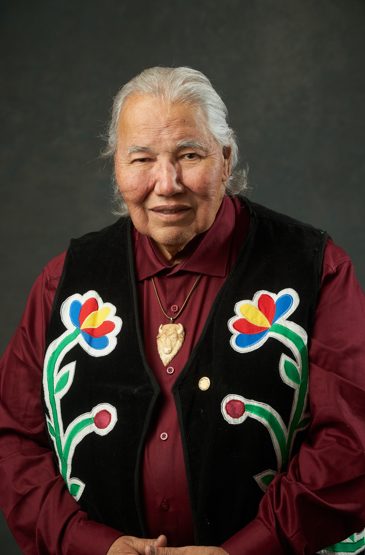 The Honorable Murray Sinclair is Anishinaabe, a member of the Peguis First Nation and a Fourth Degree Chief of the Midewiwin Society. His Spirit Name is Mizhana Gheezhik (The One Who Speaks of Pictures in the Sky). He graduated from law school in 1979. He has been involved with the justice system in Manitoba for over 40 years, first as a lawyer representing Indigenous clients, as an Adjunct Professor of Law at Robson Hall, as Associate Chief Judge of Manitoba’s Provincial Court and as a Justice of the Court of Queen’s Bench. He was the first Indigenous Judge appointed in Manitoba and Canada’s second. He served as Co-Chair of the Aboriginal Justice Inquiry of Manitoba and as Chief Commissioner of Canada’s Indian Residential Schools Truth and Reconciliation Commission (TRC). In 2017 Governor General Julie Payette awarded him and the other TRC Commissioners the Meritorious Service Cross (Civilian) (MSC) for service to Canada for their work on the TRC. He was a member of the faculty of the National Judicial Institute and has won numerous awards, including the National Aboriginal Achievement Award, the Manitoba Bar Association’s Equality Award (2001), its Distinguished Service Award (2016) and the CBA President’s medal (2018). He has received Honorary Doctorates from 19 universities. He retired from the Bench in January 2016, and was appointed to the Senate on April 2, 2016, retiring from the Senate in 2021, to return to the practice of law and to mentor young lawyers. He continues to maintain an active public speaking schedule and was named the 15th Chancellor of Queen’s University in July 2021.
The Honorable Murray Sinclair is Anishinaabe, a member of the Peguis First Nation and a Fourth Degree Chief of the Midewiwin Society. His Spirit Name is Mizhana Gheezhik (The One Who Speaks of Pictures in the Sky). He graduated from law school in 1979. He has been involved with the justice system in Manitoba for over 40 years, first as a lawyer representing Indigenous clients, as an Adjunct Professor of Law at Robson Hall, as Associate Chief Judge of Manitoba’s Provincial Court and as a Justice of the Court of Queen’s Bench. He was the first Indigenous Judge appointed in Manitoba and Canada’s second. He served as Co-Chair of the Aboriginal Justice Inquiry of Manitoba and as Chief Commissioner of Canada’s Indian Residential Schools Truth and Reconciliation Commission (TRC). In 2017 Governor General Julie Payette awarded him and the other TRC Commissioners the Meritorious Service Cross (Civilian) (MSC) for service to Canada for their work on the TRC. He was a member of the faculty of the National Judicial Institute and has won numerous awards, including the National Aboriginal Achievement Award, the Manitoba Bar Association’s Equality Award (2001), its Distinguished Service Award (2016) and the CBA President’s medal (2018). He has received Honorary Doctorates from 19 universities. He retired from the Bench in January 2016, and was appointed to the Senate on April 2, 2016, retiring from the Senate in 2021, to return to the practice of law and to mentor young lawyers. He continues to maintain an active public speaking schedule and was named the 15th Chancellor of Queen’s University in July 2021.
Niigaan Sinclair
 Niigaan Sinclair is Anishinaabe (St. Peter’s/Little Peguis) and a professor at the University of Manitoba, where he holds the Faculty of Arts Professorship in Indigenous Knowledge and Aesthetics in the Department of Indigenous Studies. Niigaan is also an award-winning writer, editor and activist who was recently named to the “Power List” by Maclean’s magazine as one of the most influential individuals in Canada. In 2018, he won Canadian columnist of the year at the National Newspaper Awards for his bi-weekly columns in The Winnipeg Free Press and is a featured member of the Friday "Power Panel" on CBC's Power & Politics. A former secondary school teacher, he won the 2019 Peace Educator of the Year from the Peace and Justice Studies Association based at Georgetown University in Washington, DC.
Niigaan Sinclair is Anishinaabe (St. Peter’s/Little Peguis) and a professor at the University of Manitoba, where he holds the Faculty of Arts Professorship in Indigenous Knowledge and Aesthetics in the Department of Indigenous Studies. Niigaan is also an award-winning writer, editor and activist who was recently named to the “Power List” by Maclean’s magazine as one of the most influential individuals in Canada. In 2018, he won Canadian columnist of the year at the National Newspaper Awards for his bi-weekly columns in The Winnipeg Free Press and is a featured member of the Friday "Power Panel" on CBC's Power & Politics. A former secondary school teacher, he won the 2019 Peace Educator of the Year from the Peace and Justice Studies Association based at Georgetown University in Washington, DC.
Murray Sinclair and Niigaan Sinclair became Honorary Members of the CSLA in May 2024.
The CSLA's Honourable Members
The Honourable T. B. McQuesten
Born in Hespeler, Ontario, T. B. McQuesten graduated from the University of Toronto with a degree in law. Mr. McQuesten was elected as a Hamilton alderman from 1918-1920.
From 1920, until his death in 1948, T.B. McQuesten served on Hamilton's Board of Parks Management and, during that time, 2,500 acres of park land was added to the city of Hamilton. In addition, he was involved in the development of the Royal Botanical Gardens and the Queen Elizabeth Way.
He was Ontario’s Highways Minister from 1934-1937, and Minister of Public Works from 1934-1937. T.B. McQuesten passed away on January 31th, 1948. (Photo: Hamilton Public Library Digitization Department via Wikimedia Commons)
T. B. McQuesten became an Honorary Member of the CSLA in 1947.
The Right Honourable William Lyon Mackenzie King
 William Lyon Mackenzie King was born in Berlin (later renamed Kitchener), Ontario in 1874. He studied economics and law at the University of Toronto and the University of Chicago and pursued studies at Harvard.
William Lyon Mackenzie King was born in Berlin (later renamed Kitchener), Ontario in 1874. He studied economics and law at the University of Toronto and the University of Chicago and pursued studies at Harvard.
In 1900, he became Deputy Minister of the new Department of Labour. In 1900, he joined the liberal party and won a seat in the 1908 election, becoming minister of labour the following year.
In 1919, he was elected leader of the Liberal party; King and the liberals won the 1921 election, the 1926 election and the 1935 election, leading Canada through the Second World War. Among his reforms, he introduced unemployment insurance and the family allowance.
He died in 1950. (Photo: Library and Archives Canada)
William Lyon Mackenzie King became an Honorary Member of the CSLA in 1949.
Mr. Jacques Greber
 Jacques Gréber was born in Paris and graduated with a M.Arch at the École des Beaux-Arts in 1908. He then worked in the US, formalizing the gardens of Harbour Hill, designing European-style gardens for American clients.
Jacques Gréber was born in Paris and graduated with a M.Arch at the École des Beaux-Arts in 1908. He then worked in the US, formalizing the gardens of Harbour Hill, designing European-style gardens for American clients.
In 1917, Gréber was completed a plan for the Benjamin Franklin Parkway, Logan Square, and the landscape for the Philadelphia Museum of Art and the Rodin Museum in Philadelphia.
His 1939 and 1950 plans for the city of Ottawa played an important role in the city’s present landscape. He authored “L’Architecture aux États-Unis” in 1920, a French-language examination of US architecture. (Photo: Cultural Landscape Foundation).
Jacques Greber became an Honorary Member of the CSLA in 1949.
Mr. George Swan Challies
Mr. Challies earned his Bachelor of Civil Law degree from McGill University in 1935 and his Master of Civil Law degree in 1947. He was a judge of the superior Court of the Province of Québec from 1949 until 1973 and Associate Chief Justice from 1963 to 1973. He worked on the Commission for the Revision of the Québec Code of Civil Procedure in addition to his teaching duties at McGill University, which conferred the degree of Doctor of Laws upon him, honoris causa, in 1966. Read Mr. Challies' obituary in the McGill Law Journal.
George Swan Challies became an Honorary Member of the CSLA in 1960.
Mr. Arthur E. K. Bunnell
Mr. Bunnell was an engineer who contributed to the 1913 City Beautiful project for the long-term planning and beautification of the city of Ottawa. During the 1920s and 1930s, he was a partner in the Toronto city planning and landscape architecture firm, Wilson, Bunnell and Borgstrom – a firm which won the competition for the North-West entrance to Hamilton, ON.
Arthur E. K. Bunnell became an Honorary Member of the CSLA in 1961.
Mr. Thomas W. Thompson
Born in 1914 next door to Toronto’s famous Casa Loma, where his father worked as a groundskeeper, Tommy Thompson obtained after-school employment looking after the gardens at Prospect Cemetery (another member of the Mount Pleasant Group of Cemeteries) on St. Clair Avenue West. After graduating from high school, Thompson enrolled at the Ontario Agricultural College in Guelph and having completed courses there in 1936, was hired as a gardener at Mount Pleasant Cemetery.
With the outbreak of war, Thompson joined the Royal Canadian Air Force and trained as a navigator-bombardier. After the war, he spent some time in the Ontario Department of Education advising communities on the care of parks, arenas and playgrounds, before becoming Parks Superintendent for the city of Port Arthur (now part of Thunder Bay), Ontario.
Thompson returned to Toronto in 1955 and became the first Parks Commissioner for the newly established Metropolitan Toronto Parks Department, a position he held for more than 20 years. Soon after the new Metro Zoo in Scarborough opened, Thompson was appointed director and helped “get the bugs” out of the new facility.
He retired in 1981, but kept busy serving on numerous committees and leading public walks around his beloved city. Some of his most popular forages were through Mount Pleasant Cemetery where he loved to talk about the unique collection of trees and shrubs.
71-year-old Tommy Thompson died at the Western Hospital on March 1, 1985. Carved on his memorial stone is a likeness of Tommy’s famous walking stick and the words that will always remind us of his love of parks and green spaces, “Please Walk on the Grass.” (Biography courtesy of Mike File)
Read 'The Man in the Bullseye', an article written by Anne Marshall and published in Toronto Life in October 1969.
Thomas W. Thompson became an Honorary Member of the CSLA in 1966.
Mr. Edouard Fiset
Edouard Fiset was born in Rimouski in 1910. He graduated from the École supérieure des beaux-arts in Paris in 1940. During the Second World War, he was interned by the Vichy regime in France as an "enemy alien'" and not freed until 1944.
At the end of the war, he advises on the reconstruction of the historic city of Caen before returning to Canada. Among his contributions are: collaborating with Jacques Gréber on the City of Ottawa Master Plan, preparing new town plans for Labrieville, Baie-Como, Port-Cartier and Churchill Falls, and the Laval University Master Plan.
In 1964, he was appointed Chief Architect for EXPO ’67 in Montreal where, in addition to developing the master plan for the fair, he designed several pavilions including the theme pavilions on Ste. Helene's Island and on Notre Dame Island, and supervised the design work of leading architects from around the world. Fiset was later elected to the Order of Canada for his achievements at the EXPO '67 site.
He died in Montreal on 27 January 1994.
Edouard Fiset became an Honorary Member of the CSLA in 1967.
Mr. Gordon Arnott
Born in Winnipeg, Mr. Arnott graduated with a Bachelor in Architecture from the University of Manitoba in 1948. He worked on the Kitimat new town in BC before moving to Regina in 1954 and establishing a multidisciplinary firm, originally called Izumi Arnott Sugiyama. This firm’s projects included Midtown Plaza in Regina and various projects at the universities of Saskatchewan and Regina. Mr. Arnott became a fellow of the RAIC in 1968 and was its president in 1970-71.
Gordon Arnott became an Honorary Member of the CSLA in 1967.
Mr. Charles-Edouard Campeau
Mr. Campeau was born in 1916. He was the Director of City Planning at the City of Montreal from the 1940s to 1958 and closely involved with many key dossiers of the time, including open spaces, the St-Lawrence Seaway and its effects on Montreal, traffic and the building of urban freeways, slum clearance, etc. He was a federal MP from 1958-1962. He died in 1992.
Charles-Edouard Campeau became an Honorary Member of the CSLA in 1967.
Dr. R. J. Hilton
Dr. Hilton was Head of Horticulture and later the first Director of the Arboretum at the University of Guelph and President/Chair of the Royal Botanical Gardens. The R. J. Hilton Centre at the Arboretum is named for him. He was a leading proponent of the establishment of an arboretum at Guelph. Dr. Hilton was the editor of The Canadian Gardener's Guide (1958). A scholarship at the University of Guelph is named in his honour. Along with Norman J. Scott and Dean Richards, he was one of the driving forces behind the first Landscape Architecture program in Canada at the University of Guelph.
R. J. Hilton became an Honorary Member of the CSLA in 1967.
Dr. N.R. Richards
Dean N. R. ("Rick") Richards was Dean of Ontario Agricultural College at the University of Guelph from 1962 to 1972. He was a soil scientist and was responsible for many of the early soil surveys in Ontario. He was an Honourary Fellow of the University of Guelph and along with Norman J. Scott and R.J. Hilton, he was one of the driving forces behind the first Landscape Architecture program in Canada at the University of Guelph. He was awarded an Honorary Doctor of Sciences degree by Laval University in 1967. He died in 2009. Read an interview with N.R. Richards by Ross Hay.
N.R. Richards became an Honorary Member of the CSLA in 1967.
The Honourable Jack Davis
John (Jack) David was born in 1916 in Kamploops, BC and graduated with a Bachelor of Applied Science from the University of British Columbia. He was chosen a Rhodes Scholar from British Columbia in 1939.
Davis was elected to the Canadian House of Commons in 1962, in 1963, when he was appointed as the Parliamentary Secretary to Prime Minister Lester B. Pearson, 1965 and 1968. He was Minister without Portfolio, Minister of Fisheries, Minister of Fisheries and Forestry, and the first Minister of the Environment in the English-speaking world.
He was defeated 1974. In 1975, he was elected to the BC Legislative Assembly as the Minister of Transport and Communication in the new. He resigned in 1978 but was re-elected in 1979, 1983 and 1986, where he was a Minister of Energy, Mines and Petroleum Resources. He died in 1991.
Jack Davis became an Honorary Member of the CSLA in 1972.
Prof. G. Angus Hills
Born into an Ontario farming family in 1902, George Angus Hills began a farming career on the Prairies in 1919, later pursuing studies at the Ontario Agricultural College (OAC) at Guelph, starting in 1934.
Through his work on the Ontario soil survey, Hills became an expert pedologist and subsequently elaborated a soil classification system that linked the characteristics of soil profiles to local environmental conditions. His system of analysing soils helped to explain their influence on agricultural production and their capacity to resist deterioration.
Hills then went to work for the Ontario Department of Lands and Forests in 1944, where he focused his research on the soils in the northern reaches of the province (including the rich lands of the Clay Belt) so as to identify the most promising locations for agricultural development.
He later directed the province’s research work in forest productivity, from 1954 to 1967. These diverse experiences helped Hills to develop a comprehensive system of land classification for agricultural, forestry, recreational, and other purposes.
His 1961 publication, The Ecological Basis of Land Use Planning, became a classic work in the field of land analysis and planning. Some of the concepts and tools developed by Hills are universally employed today in landscape planning at the regional scale: the division of natural continuums into graduated classes for purposes of analysis and comparison; the concepts of capability, suitability, and feasibility for their potential applications to sites and landscapes; the division of large territories into landscape units; and the use of alternative hypothetical scenarios to explore the likely impacts of different interventions in the landscape. (Biography by Ron Williams)
George Angus Hills became an Honorary Member of the CSLA in 1978.
 Mr. Roberto Marx
Mr. Roberto Marx
Roberto Burle Marx was born in 1909 in Sao Paulo, Brazil and attended the National School of Fine Arts in Rio in 1930. He designed his first landscape for a private residence, the Schwartz house, in 1932. In 1949, he acquired a large estate outside Rio de Janeiro and began making expeditions into the rain forest with botanists, landscape architects, architects and other researchers to gather plant specimens. This property is now a national monument. He founded a studio in 1955 with an eventual branch in Caracas, Venezuela. In addition to landscape architecture, he was a painter, print maker, conservationist, ecologist, naturalist, artist and musician. He is accredited with being the founder of modernist landscape architecture in Brazil. He died in 1994. (Photo: flickr)
Roberto Marx became an Honorary Member of the CSLA in 1980.
The Honourable Justice Thomas R. Berger, Q.C.
Thomas Berger was born in Victoria, BC, in 1933. He was elected to the House of Commons in 1962 but was defeated the following year. Re-elected in 1966, he won the NDP leadership shortly after. He was appointed to the Supreme Court of British Columbia on 1972 and served until 1983. He is best known for his work as the Royal Commissioner of the Mackenzie Valley Pipeline Inquiry and his assertions that both Canadian Aboriginals and women’s had to be included in a Charter of Rights. He lead the Alaska Native Review Commission in 1983-1985, was appointed chair of the Vancouver Election Commission in 2003, and in 2005, was appointed Conciliator to resolve the impasse of the Government of Canada, Government of Nunavut and Nunavut Tunngavik Incorporated in reaching a common way forward for the Nunavut Land Claims Implementation Contract. He was made an Officer of the Order of Canada in 1989 and in 2012, he was awarded the Queen Elizabeth II Diamond Jubilee Medal. (Photo: Martha Harbell)
Thomas R. Berger became an Honorary Member of the CSLA in 1981.
Mr. Patrick Joseph Moran
This horticulturalist and landscape architect is best-known for his work at the Wascana Centre Authority in Regina, SK. Under his guidance, the park became renowned for its beauty. He was involved in many professional organizations and has also been active in a number of cultural societies and has done much-needed volunteer work locally and in the developing world. He died in 2010.
Patrick Joseph Moran became an Honorary Member of the CSLA in 1982.
Norman J. Scott 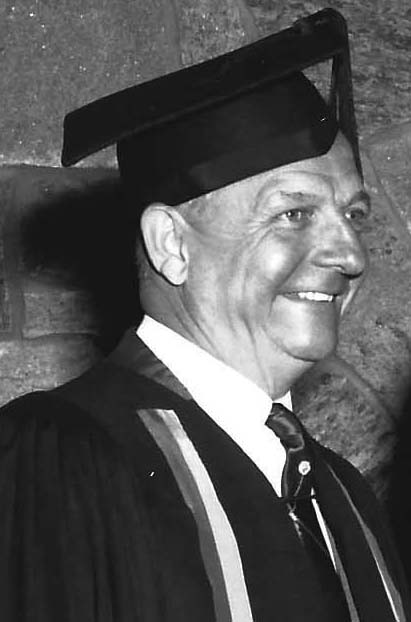
Norman J. Scott (1912-1991) was a 1937 OAC (Guelph) Ornamental Horticulture graduate and a 1939 Ohio State MSc graduate in Plant Physiology. He managed, and later owned Brookdale-Kingsway Nurseries in Bowmanville, Ontario from 1939 to 1959 when he retired to Toronto and founded the Canadian Horticultural Consulting Co. Limited.
During his “retirement”, Mr. Scott was a Trustee of the Centennial Centre of Science and Technology (the Science Centre, Toronto); a member of the Metropolitan Toronto and Region Conservation Authority, (now TRCA), and many industry and trade associations in the 1960s and 1970s. He was a member of the University of Guelph Board of Governors (1965-1970), and with Dr. R. J. Hilton, Dean N. R. Richards, Leslie Hancock and others, responsible for promoting the first Canadian program in Landscape Architecture at the University of Guelph. In the early 1970s, he lobbied the Province of Ontario on behalf of the OALA that eventually led to the passing of the OALA Act.
Norman J. Scott became an Honorary Member of the CSLA in 1982.
Mayor Jean Drapeau
Jean Drapeau was born in Montreal in 1916. He won the 1954 Montreal city election and began transforming the city to a world metropolis of the first rank. Promising Montréal a subway and clean government, he was re-elected in 1960. In addition, he reformed the electoral system and modernized the police department, brought the Montreal Expos to the city and the summer Olympics. He resigned in 1986 due to declining health and finished his career as Canadian ambassador to UNESCO in Paris. He died in 1999. (Photo: Le Devoir)
Jean Drapeau became an Honorary Member of the CSLA in 1984.
Mr. Dieter Martin
 Dieter Martin received a Diploma in Ornamental Horticulture from the Bavarian Ministry of Nutrition, Agriculture and Forestry in Aschaffenburg, West Germany, in 1949. He was a Parks & Urban Spaces Project Manager in Aschaffenburg until 1953, when he emigrated to Canada.
Dieter Martin received a Diploma in Ornamental Horticulture from the Bavarian Ministry of Nutrition, Agriculture and Forestry in Aschaffenburg, West Germany, in 1949. He was a Parks & Urban Spaces Project Manager in Aschaffenburg until 1953, when he emigrated to Canada.
Dieter accepted a position as Assistant Grounds Superintendent at the University of Alberta in Edmonton, working extensively with Hugh Knowles. In 1957, at age 26, he moved to Saskatoon as Head Gardener at the University of Saskatchewan.
Dieter pioneered tree moving on the Prairies, and consistently advocated for the importance of landscape to support learning. With a particularly articulate and persistent character, he was instrumental in ensuring professional design input on U of S projects, initially by contracting Vancouver-based Clive Justice, the nearest landscape architect at the time. The exceptional landscape image of the U of S campus can be largely attributed to Dieter’s influence. A more detailed vignette of his time at the U of S can be found on YouTube: “Landscaping at the U of S - A Storied History”.
In 1976, he opened Dieter Martin Greenhouse Ltd., a modest, delightful nursery and greenhouse operation in Langham SK, involving three family generations. With extraordinary knowledge and skill set, he also began consulting for various clients, including the University of Manitoba and the Meewasin Valley Authority.
With unbridled enthusiasm and energy, Dieter continues to promote landscape architecture as an integral discipline for development projects and to contribute to the advancement of the landscape industry.
Dieter Martin became an Honorary Member of the CSLA in 1985.
Photo courtesy of Rob Crosby.
The Honourable Tom MacMillan
Tom MacMillan was born in 1945 in Charlottetown, PEI. He was educated at the universities of Prince Edward Island, Queen's, New Brunswick and Trent in political science. Before he was elected to the House of Commons in 1979, he was a guest lecturer in political science at Laurentian University, instructor at Sir Sandford Fleming College, special assistant to the Progressive Conservative (PC) house leader, the Honourable Robert Stanfield, executive director of Mr. Stanfield's policy advisory committee, executive officer of the Ontario Human Rights Committee and chairman of the Book and Periodical Development Council of Canada. In 1984, he was named Canada's first full-time minister of state for tourism. He held this portfolio until mid-1985, when he was named minister of the environment until 1988.
Tom MacMillan became an Honorary Member of the CSLA in 1989.
Dr. Jennifer Shay
Born in Hull, England, Dr. Jennifer Shay received a Bachelor of Science from the University of London in 1952. She moved to Canada in 1957 and completed her Master of Science and her Doctor of Philosophy in Science in 1964 at the University of Manitoba where, in 1965, she became an assistant professor, promoted to associate professor in 1967, and full professor in 1975.
She was the founding director of the Delta Marsh Field Station from 1966 to 1986. She was appointed Professor Emerita of Botany in the Faculty of Science at the University of Manitoba in 1995. In 1988, she was made a Member of the Order of Canada and was promoted to Officer in 2000.
Among her list of awards and distinctions are the Shikar-safari Conservation Award, (1970), life-time membership to the Manitoba Naturalist Society (1976), the Canadian Nature Federation Douglas Pimlott Conservation Award (1979), the Manitoba Naturalist Society Ernest Thompson Seaton Distinguished Naturalist Award (1982), honorary life-time membership to the Manitoba Museum of Man and Nature (1982), the Canadian Botanical Association Distinguished Service Award (1984), the Peter D. Curry Chancellor's Award (1987), Member of the Order of Canada (1988), honorary life-time membership to the Manitoba Association of Landscape Architects (1990), University of Manitoba Outreach Award (1990), University of Manitoba H.H. Saunderson Teaching Award (1992), the Canadian Parks and Wilderness Society J.B. Harkin Medal (1992), the Manitoba Eco-network Environmental Award (1993), Honorary Member of the Canadian Society of Landscape Architects (1994), the Canadian Healthy Environment Award for Lifetime Achievement (1996), YWCA Woman of Distinction (1997), and Officer of the Order of Canada (2001).
Read an article about Jennifer Shay
Jennifer Shay became an Honorary Member of the CSLA in 1991.
Mrs. Pleasance Crawford
Pleasance Kaufman Crawford is a Toronto-based landscape-design historian. She graduated from Oberlin College and the University of Toronto. For 25 years, she specialized in research, documentation, and assessment of Canadian cultural landscapes, often as a member of a multidisciplinary team of heritage professionals.
She co-edited an anthology entitled Garden Voices: Two Centuries of Canadian Garden Writing (Toronto: Random House of Canada, 1995; Vintage Canada, 1997) and has served on the boards of the Ontario Association of Landscape Architects, the Canadian Association of Professional Heritage Consultants, and the Friends of the Archives of Ontario. (Photo: Charles Crawford)
Pleasance Crawford became an Honorary Member of the CSLA in 1993.
Prof. Roger B. Martin
Roger B. Martin was born in Minnesota and received his Bachelor of Science in Horticulture at the University of Minnesota in 1958 before completing his Master of Landscape Architecture degree at Harvard University.
In 1961, he was awarded the Prix De Rome Fellowship to the American Academy in Rome before taking a position as an Assistant Professor at the College of Environmental Design at Berkeley Campus of the University of California. In 1966, he was asked to develop degree studies in Landscape Architecture at the University of Minnesota. He co-founded InterDesign, Inc. in 1969, an interdisciplinary design firm focused on creative problem solving within a group format and which resulted in, among others, the Minnesota Zoological Garden, the renovation of over 50 miles of Minneapolis Parkway System and the development of the central riverfront in Minneapolis.
From 1984–1998, he was a partner in Martin and Pitz Associates. In 1980, he worked at the University of Melbourne. He received the Bradford Williams Medal given by the ASLA for outstanding professional papers in 1968 and 1969.
Roger B. Martin became an Honorary Member of the CSLA in 1993.
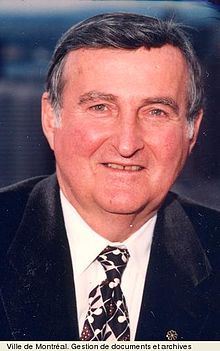 Mayor Pierre Bourque
Mayor Pierre Bourque
Pierre Bourque was born in 1942. He was director of the Montreal Botanical Gardens from 1980 to 1994. He founded the Vision Montreal political party and served as mayor of Montreal from 1994 to 2001. He supported the creation of parks, implemented tree-planting initiatives, as well as creating Eco-Centres (reusable materials) and Eco-Quartier program (recycling). (Photo: Ville de Montréal, Gestion de documents et archives)
Pierre Bourque became an Honorary Member of the CSLA in 1995.
 Mr. Malak Karsh
Mr. Malak Karsh
Malak Karsh was born Mardin, Ottoman Empire, in 1915. He emigrated to Canada in 1937 and worked with his brother Yousuf Karsh. In 1963, he took a picture of the floating logs on the Ottawa River, called Paper and Politics, which was put on the back of the 1969-1979 series Canadian $1 note. He was one of the founders of the Canadian Tulip Festival and its honorary president at the time of his death. In 1996, he was made an Officer of the Order of Canada. He died in 2001. (Photo: George Hunter, R.C.A.)
Malak Karsh became an Honorary Member of the CSLA in 2000.
Mrs. Jean E. Pigott
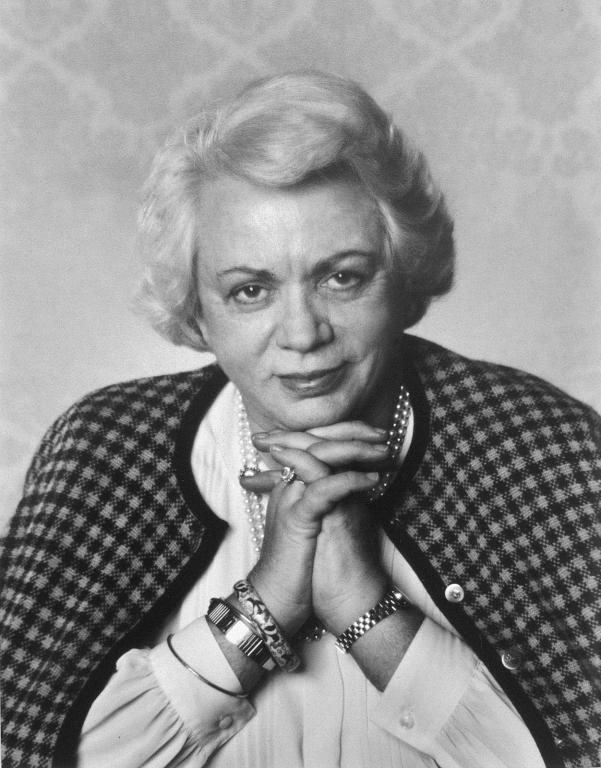 Jean Elizabeth Morrison Pigott was born in 1924. She was was president and CEO of her family's business, Morrison-Lamothe Bakery, one of only three women CEOs in Canada in the early 1970s. In 1976, she won a by-election in Ottawa—Carleton riding and became a Member of Parliament in the Canadian House of Commons as a Progressive Conservative.In 1979, after losing her seat, Joe Clark, hired her as an advisor.
Jean Elizabeth Morrison Pigott was born in 1924. She was was president and CEO of her family's business, Morrison-Lamothe Bakery, one of only three women CEOs in Canada in the early 1970s. In 1976, she won a by-election in Ottawa—Carleton riding and became a Member of Parliament in the Canadian House of Commons as a Progressive Conservative.In 1979, after losing her seat, Joe Clark, hired her as an advisor.
In 1984, she was appointed by Mulroney as chair of the National Capital Commission. She was also the first woman to sit on the board of directors of Ontario Hydro and also sat on the board of Canadian Tire Corporation. She has also served as chair of the board of the Ottawa Congress Centre and the Centre for Studies of Children at Risk in Hamilton, Ontario. In 1995, she was made an Officer of the Order of Canada . Jean Pigott died in 2012. (Photo: National Capital Commission)
Jean E. Pigott became an Honorary Member of the CSLA in 2000.
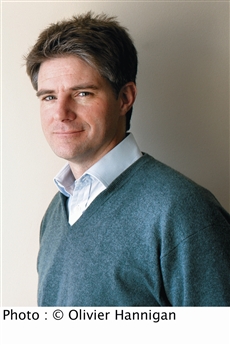 Alexander Reford
Alexander Reford
Alexander Reford was borin in Ottawa in 1962. He obtained degrees from the University of Toronto and Oxford University. He was Dean of College at St. Michael’s College at the University of Toronto from 1987 to 1995 and left to assume the directorship of Les Jardins de Métis (Reford Gardens).
The great-grandson of Elsie Reford, creator of the Gardens, he was instrumental in creating the not for profit organization that purchased them from the Quebec government in 1995. Under his stewardship, a complete restoration of the gardens and the historic buildings on the property has been undertaken. In addition, h
e co-founded the International Garden Festival.
He is a member of the board of directors of the Canadian Tourism Commission and president of the Association touristique régionale de la Gaspésie. Reford has authored numerous books and articles and is a frequent contributor to the Dictionary of Canadian Biography.
Additionally, he is the author of the biographies of Lord Mount Stephen and Lord Strathcona and his great great grandfathers, Robert Meighen and Robert Reford. (Photo: Oliver Hannigan)
Alexander Reford became an Honorary Member of the CSLA in 2001.
 The Honourable Peter Lougheed, P.C., C.C., Q.C.
The Honourable Peter Lougheed, P.C., C.C., Q.C.
Edgar Peter Lougheed was born in Calgary in 1928. After a short football career he graduated from the University of Alberta, entered business and practised law in Calgary. In 1965, he was elected leader of the Alberta Progressive Conservative Party. As premier, he furthered the development of the oil and gas resources, started the Alberta Heritage Fund and introduced the Alberta Bill of Rights. In addition, he was instrumental in Calgary’s successful bid to host the 1988 Winter Olympics. In 1986, he was named a Companion of the Order of Canada and in 1989 he was named to the Alberta Order of Excellence. He died in 2012. (Photo: Glenbow Museum)
Peter Lougheed became an Honorary Member of the CSLA in 2001.
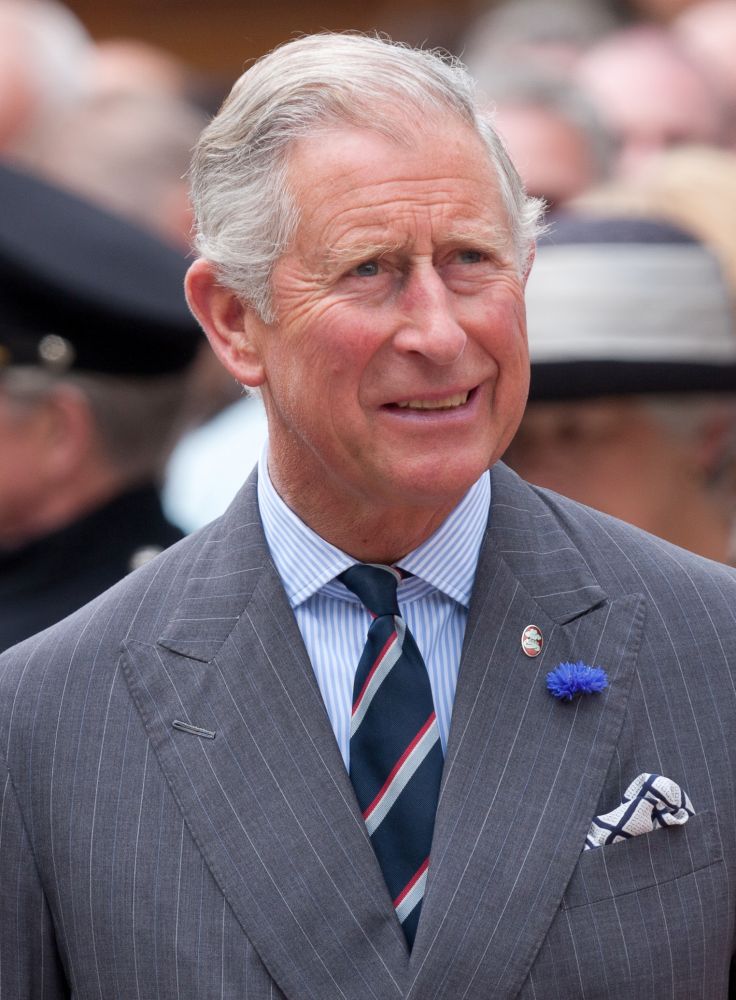 HRH Prince Charles, the Prince of Wales
HRH Prince Charles, the Prince of Wales
The Prince of Wales was born at Buckingham Palace in 1948. He attended Cambridge University in 1967 and read archaeology and anthropology, then history at Trinity College. In 1970, he took his seat in the House of Lords. In 1971, he embarked on a naval career. His Royal Highness has, over the years, developed a wide range of interests which are today reflected in The Prince's Charities, a group of not-for-profit organizations of which The Prince of Wales is Patron or President. His interest in fields such as the built environment, global sustainability, youth opportunity, education and faith have been elaborated over many years in a large number of speeches and articles. (Photo: flickr)
Read the June 2001, CSLA Bulletin article on HRH Prince Charles' Honorary Membership
Prince Charles became an Honorary Member of the CSLA in 2001.
Mr. Larry Beasley
Larry Beasley was born in 1948. In In 2004, he was made a Member of the Order of Canada in recognition for having "played a leading role in transforming" Vancouver's "downtown core into a vibrant, livable urban community". Throughout his career in public service, Beasley has been engaged in community initiatives, including the Institute for Canadian Citizenship. He was recently Co-Director of Planning for the City Of Vancouver and is credited with the transformation of its downtown core along New Urbanism lines.
Larry Beasley became an Honorary Member of the CSLA in 2006.
Mr. Julian Smith
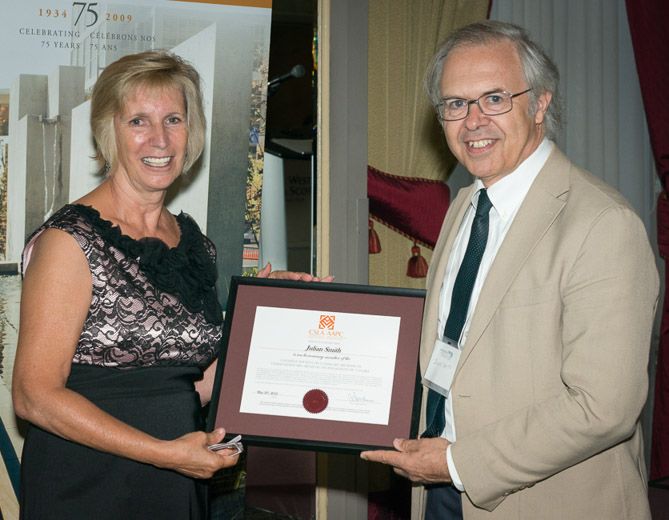 Mr. Smith was born in Montreal but spent his childhood in Delhi, India; and Cambridge, Massachusetts He studied at Oberlin, MIT and Cornell then worked at the Institute for Architecture and Urban Studies in New York City. He moved to Canada and eventually became Chief Restoration Architect for the National Historic Sites program.
Mr. Smith was born in Montreal but spent his childhood in Delhi, India; and Cambridge, Massachusetts He studied at Oberlin, MIT and Cornell then worked at the Institute for Architecture and Urban Studies in New York City. He moved to Canada and eventually became Chief Restoration Architect for the National Historic Sites program.
He established his own architectural and planning practice, and also founded and directed the graduate program in Heritage Conservation at Carleton University. Among his projects are the restoration of the Vimy Monument in France, the Aberdeen Pavilion in Ottawa, and the Lister Block in Hamilton, and master plans for the Parliament Buildings in Toronto, the Central Experimental Farm in Ottawa, and a new campus for a historic college in south India.
He has developed policy documents for a variety of federal and provincial agencies in Canada, and has been Canadian delegate to UNESCO for the drafting of the new international recommendation on Historic Urban Landscapes. He is architectural advisor to the Trustees of Queen's University, a past member of the Advisory Committee to the Minister of Canadian Heritage, and a frequent contributor to international forums.
He is a recipient of Heritage Canada's Gabrielle Léger Award and the Architectural Conservancy of Ontario's Eric Arthur Award, both recognizing lifetime achievement in the heritage conservation field. Mr. Smith is currently the executive director of the Willowbank School for the Restoration Arts and the director of the Centre for Cultural Landscape, co-located in Queenston, Ontario. (Photo: Jean Landry)
Julian Smith became an Honorary Member of the CSLA in 2012.
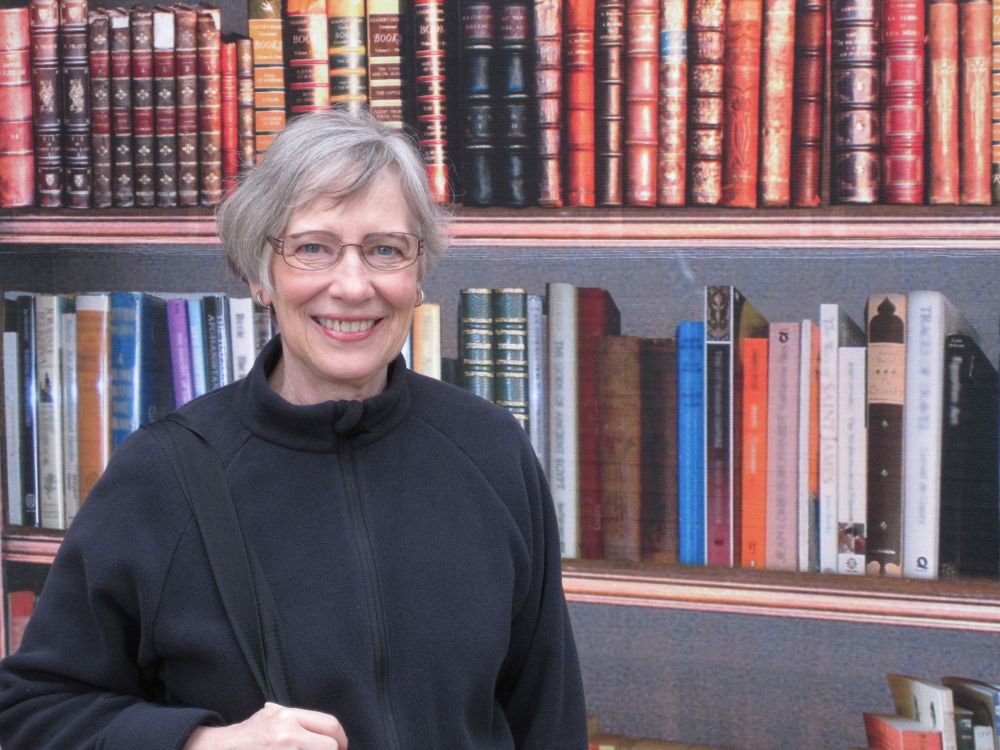 Ms. Susan Buggey
Ms. Susan Buggey
Susan Buggey has long been interested in cultural landscapes and active in research, evaluation and writing related to them. At Parks Canada, from historian to senior manager, she worked for the multi-disciplinary research program on history and the built environment, including cultural landscapes.
She played a key role in developing the concept of cultural landscapes within the program and later more broadly. She also taught historic landscape conservation and cultural landscapes in various short courses and at the universities of Manitoba, Montréal and Victoria.
In the early 1990s she participated in UNESCO’s international expert meetings to develop guidelines for inclusion of cultural landscapes on the World Heritage List, which remained an area of interest and activity.
Since 1975 she has contributed articles to various national and international publications. Her recent research and writing has focused on aboriginal cultural landscapes, where she contributed to developing the concept, and on associative values of cultural landscapes.
As one of the founders of the Alliance for Historic Landscape Preservation and a fellow of the Association for Preservation Technology, she has been actively engaged for more than 35 years in national and international organizations related to heritage conservation. They currently include the ICOMOS/IFLA International Scientific Committee on Cultural Landscapes and a working group of IUCN’s World Commission on Protected Areas. Ms. Buggey passed away in 2015.
Read Ron Williams' tribute to CSLA Honourary Member Susan Buggey
Susan Buggey became an Honorary Member of the CSLA in 2014.
Dr. Mary-Ellen Tyler
Dr. Tyler has interdisciplinary graduate degrees in environmental design and resource management and close to forty years of professional practice and research in environmental planning, landscape ecology, water resource management, and ecological design.
She has participated in international projects in China, Thailand, Mexico, Peru and Ecuador and has received NSERC, SSHRC, CMHC, and Canadian Water Network support for research related to urbanizing watersheds, land use and water management, and cumulative effects of energy development in landscapes and watersheds.
Dr. Tyler has worked professionally for Landscape Architecture and Planning firms in Alberta and BC and the Government of Canada in a number of roles related to planning and design of major resource development projects.
Her first academic appointment was in the University of Waterloo’s School of Urban and Regional Planning. Subsequently, she served as Associate Dean of Architecture at University of Manitoba where she taught in both City Planning and Landscape Architecture and in 1998 was appointed as Dean of the Faculty of Environmental Design at the University of Calgary.
She was a founder of the Alberta Low Impact Development Partnership, a member of Infrastructure Canada’s national working group on municipal infrastructure and land use best practice, and served as a member of the CSLA’s Accreditation Council for five years.
She is a co-recipient of an international juried award of merit for her urban ecological design work on the Okotoks Sustainable Community Design project and received an achievement award from the Grand River Conservation Authority for her ecological restoration work. She has supervised the completion of close to one hundred graduate students during her academic career and has received two awards for excellence in graduate supervision. Dr. Tyler recently played a major role in the successful development of the new Master of Landscape Architecture program at the University of Calgary. Read the press release
Mary-Ellen Tyler became an Honorary Member of the CSLA in 2016.
Candace Wasacase Lafferty
 Candace Wasacase Lafferty is a Cree and Saulteaux citizen of the Kahkewistahaw First Nation, Treaty 4 Territory in southern Saskatchewan. A graduate of the University of Saskatchewan, Candace has held many impressive positions on and off campus, leading and contributing to iconic and meaningful landscape architectural work in her home province. At the University of Saskatchewan, she held many roles including the Director of Indigenous Engagement, Senior Director of the Gordon Oakes Red Bear Student Centre, Director for Honoring Nations Canada on behalf of Johnson Shoyama School of Public Policy and Fulbright Canada. Prior to joining the University of Saskatchewan, Candace held roles within the Federation of Sovereign Indigenous Nations, the Saskatoon Tribal Council, and the Saskatchewan Indian Institute of Technologies. As the longest serving Chair of the Wanuskewin Heritage Park Board, Candace played a lead role in the revitalization of the Park, including the vision for the UNESCO World Heritage site designation. Ms. Wasacase Lafferty understands and upholds the spiritual values held by the Land. She values, teaches, and endorses connection to land protection, integral to design within the discipline of landscape architecture. This connection honours the spirit of reconciliation. Her leadership and vision have been pivotal in major multi-million-dollar infrastructure projects such as Wanuskewin Heritage Park and the realization of the Gordon Oakes Red Bear Student Centre, University of Saskatchewan. The value and dedication that Ms. Wasacase Lafferty meaningfully contributes to landscape architecture in Saskatchewan is profoundly important to the profession at both a local and national scale.
Candace Wasacase Lafferty is a Cree and Saulteaux citizen of the Kahkewistahaw First Nation, Treaty 4 Territory in southern Saskatchewan. A graduate of the University of Saskatchewan, Candace has held many impressive positions on and off campus, leading and contributing to iconic and meaningful landscape architectural work in her home province. At the University of Saskatchewan, she held many roles including the Director of Indigenous Engagement, Senior Director of the Gordon Oakes Red Bear Student Centre, Director for Honoring Nations Canada on behalf of Johnson Shoyama School of Public Policy and Fulbright Canada. Prior to joining the University of Saskatchewan, Candace held roles within the Federation of Sovereign Indigenous Nations, the Saskatoon Tribal Council, and the Saskatchewan Indian Institute of Technologies. As the longest serving Chair of the Wanuskewin Heritage Park Board, Candace played a lead role in the revitalization of the Park, including the vision for the UNESCO World Heritage site designation. Ms. Wasacase Lafferty understands and upholds the spiritual values held by the Land. She values, teaches, and endorses connection to land protection, integral to design within the discipline of landscape architecture. This connection honours the spirit of reconciliation. Her leadership and vision have been pivotal in major multi-million-dollar infrastructure projects such as Wanuskewin Heritage Park and the realization of the Gordon Oakes Red Bear Student Centre, University of Saskatchewan. The value and dedication that Ms. Wasacase Lafferty meaningfully contributes to landscape architecture in Saskatchewan is profoundly important to the profession at both a local and national scale.
Candace Wasacase Lafferty became an Honorary Member of the CSLA and SALA in June 2023.